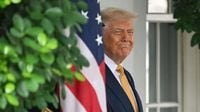On the morning of September 2, 2025, a U.S. military drone strike in the Caribbean Sea sent shockwaves through international corridors and reignited fierce debate at home. The target: a speedboat linked to the Venezuelan drug cartel Tren de Aragua, designated earlier this year as a Foreign Terrorist Organization by the Trump administration. The result: eleven people dead, a vessel sunk, and a region on edge as the United States signaled a new, more aggressive front in its decades-long war on drugs.
President Donald Trump wasted no time in taking credit for the operation. Announcing the strike on his Truth Social account, he declared, “Earlier this morning, on my orders, US military forces conducted a kinetic strike against positively identified Tren de Aragua narco-terrorists.” He was quick to add a warning: “Please let this serve as notice to anybody even thinking about bringing drugs into the United States of America. BEWARE!” According to The Washington Post, Trump further claimed that the strike occurred in international waters as the group was allegedly transporting illegal narcotics to the U.S. No U.S. forces were harmed in the operation, he assured.
For the Trump administration, this was not just a one-off show of force. In July 2025, Trump signed an executive order classifying several Latin American drug cartels—including Tren de Aragua and Mara Salvatrucha (MS-13)—as terrorist organizations, citing their threat as “a national-security threat beyond that of traditional organized crime.” Simultaneously, the administration designated Venezuela’s Cartel de los Soles as a Specially Designated Global Terrorist group and labeled President Nicolás Maduro “Terrorist Number One,” with a $50 million bounty placed on his arrest. The U.S. Justice and State Departments cited previous indictments related to drug trafficking as justification.
Behind the scenes, a classified directive gave the Pentagon broad authority to use military force against Latin American cartels—an unprecedented move, as such tasks have historically fallen to law enforcement. By August, the U.S. had amassed its largest military presence in the Caribbean since the Cold War, deploying eight warships, F-35 fighter jets to Puerto Rico, Navy P-8 surveillance aircraft, an attack submarine, and a Marine Expeditionary Unit. The USS Jason Dunham and USS Gravely, both guided-missile destroyers, were repositioned to southern Caribbean waters, and the USS Sampson docked in Panama. “They are not there for sightseeing,” a former U.S. special operator told RTÉ News. “Marine Expeditionary Units can specialize in raids on terrorist camps.”
Allies in Washington cheered the strike. Vice President JD Vance called it “the highest and best use of our military,” and Secretary of State Marco Rubio announced in Mexico City, “we are going to wage combat against drug cartels that are flooding American streets and killing Americans.” Pete Hegseth, who now heads the Department of Defense—recently renamed the Department of War by Trump in a symbolic gesture—told Fox News, “it won’t stop with just this strike ... anyone else trafficking in those waters who we know is a designated narco-terrorist will face the same fate.” Trump himself told reporters, “There’s more where that came from.”
But the operation drew immediate and scathing criticism from across the political spectrum and the globe. On his podcast, former “Meet The Press” moderator Chuck Todd likened the strike to Russian President Vladimir Putin’s tactics in Ukraine. “We’re sitting here behaving no different than Putin’s been behaving in his region,” Todd said, expressing alarm at what he saw as a disregard for constitutional and legal process. “This is the same crap that Putin’s pulling, except he’s not in a democracy and we are!”
Independent Veterans of America founder Paul Rieckhoff called the strike “alarming, unprecedented and dangerous” on MSNBC, and warned it was “the latest example of how Trump continues to overextend and abuse military power.” Democratic Congresswoman Ilhan Omar introduced a resolution to curb Trump’s executive use of military force, arguing, “There was no legal justification for the Trump Administration’s military escalation in the Caribbean,” as reported by The Intercept. Senator Rand Paul, a Republican, was equally blunt: “What a despicable and thoughtless sentiment it is to glorify killing someone without a trial,” he wrote on X.
Legal experts quickly weighed in, highlighting the lack of congressional authorization for such military action. Christine Ryan of Columbia Law School told RTÉ News that lethal force is permissible under international law “only as a last resort when it is strictly necessary to protect human life, and only where less harmful means (for example, interception or capture of the boat) are not available.” She added, “Rebranding the victims as 'terrorists' does not confer such authority.”
In Venezuela, the strike was denounced as murder and a “fabricated pretext” to overthrow the government. President Nicolás Maduro vowed to deploy military defenses across the country and accused the U.S. of “openly confessing to killing 11 people.” Venezuela’s interior minister, Diosdado Cabello, asserted that the people on board were not gang members and that their families were demanding answers.
Reactions across Latin America were mixed. Brazil’s President Lula called the U.S. buildup “dangerously destabilising,” while Mexico warned against violations of sovereignty. Colombia’s President Petro labeled the boat strike “murder” and “disproportionate.” However, Trinidad and Tobago’s Prime Minister Kamla Persad-Bissessar and Ecuador’s President Daniel Noboa expressed gratitude for the U.S. action against what they termed terrorist threats. Human rights groups, meanwhile, condemned the strike as an extrajudicial killing, and both Russia and China criticized the United States for what they saw as unwarranted interference.
The backdrop to this military escalation is Venezuela’s ongoing economic and humanitarian crisis. According to an IMF paper cited in Firstpost, the country’s GDP has plummeted by over 75% in the past decade, and more than 8 million people—about a quarter of the population—have been displaced. Even a limited conflict could prove catastrophic for a nation already on the brink.
Some analysts question the strategic wisdom of focusing on Venezuela. A New York Times report from September 3, 2025, revealed that 76 percent of drug smuggling into the U.S. occurs via the Pacific, not the Caribbean, and that Venezuela produces little cocaine compared to Colombia. When it comes to fentanyl, Venezuela is largely irrelevant; Mexico and Chinese chemicals dominate that pipeline.
Yet, the Trump administration appears undeterred. On September 4, tensions ratcheted up further as Venezuelan F-16s overflew the USS Jason Dunham, prompting the U.S. to deploy 10 additional F-35 stealth fighters to Puerto Rico and warn of the possibility of shooting down any Venezuelan aircraft threatening U.S. forces. Trump’s symbolic renaming of the Pentagon as the “Department of War” underscored his increasingly militarized approach, even if the move carried no legal weight.
The world is watching with concern. Even minor skirmishes could spiral, threatening commercial shipping and the stability of the region. As Juan Gonzalez, a former Biden advisor, told The Guardian, “I increasingly fear that the Trump administration may stumble into an intervention scenario in Venezuela, which would be frankly disastrous.”
For now, the only certainty is uncertainty. With the U.S. flexing military muscle in the Caribbean and political tempers flaring at home and abroad, the risk of escalation remains ever-present. The consequences—for Venezuela, the region, and the U.S.—are yet to be fully realized, but the stakes could hardly be higher.




